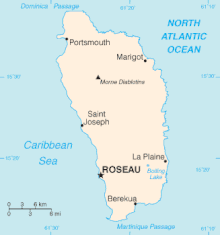This article needs additional citations for verification. (November 2009) |
| Part of a series on the |
| Culture of Dominica |
|---|
 |
| History |
| Languages |
| Cuisine |
| Religion |
| Music |
| Sport |

The culture of Dominica is formed by the inhabitants of the Commonwealth of Dominica. Dominica is home to a wide range of people. Although it was historically occupied by several native tribes, it was the Taíno and Island Caribs (Kalinago) tribes that remained by the time European settlers reached the island. "Massacre" is a name of a river dedicated to the murders of the native villagers by both French and British settlers, because the river "ran red with blood for days." Each (French and British) claimed the island and imported slaves from Africa. The remaining Caribs now live on a 3,700-acre (15 km2) Carib Territory on the east coast of the island. They elect their own chief.
Dominica is often seen as a society that is migrating from collectivism to that of individualism. The economy is a developing one that previously depended on agriculture. Signs of collectivism are evident in the small towns and villages that are spread across the island.
Dominican cuisine is similar to that of other Caribbean countries. Common main courses comprise meat (usually chicken, but can be goat, lamb, or beef) covered in sauce. The sauces are either spicy pepper sauces, or concoctions made from local fruit. A huge variety of local fruit, from tamarind to passion fruit, are served on the island, usually in juice or sauce form. Soursop is peeled and eaten raw. Sorrel, a red flower that only blooms around Christmas, is boiled into a bright red drink.